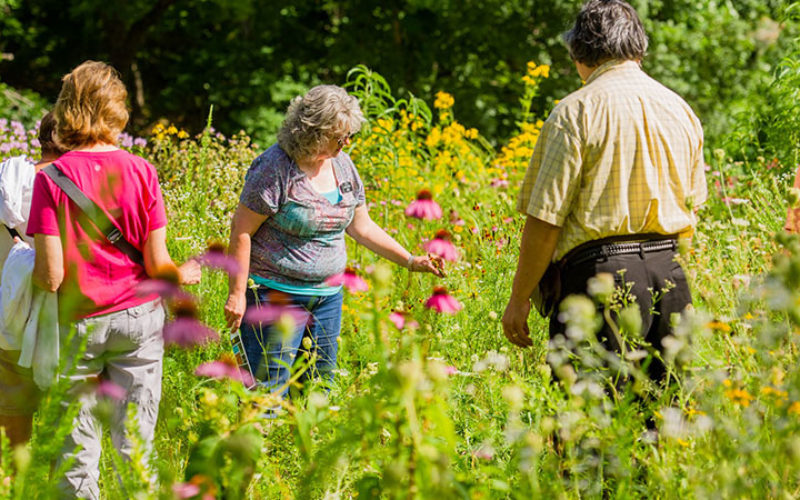Crystal Bridges’ grounds always ready for a closeup
JOCELYN MURPHY
jmurphy@nwadg.com
Most everyone familiar with the museum knows how important complimenting, reflecting and celebrating nature is at Crystal Bridges Museum of American Art in Bentonville. The building itself was designed with these ideals in mind and is surrounded by a 120-acre park comprising areas with unique characteristics, more than 3.5 miles of trails and outdoor artworks and installations. Have you ever considered, though, the effort that goes into making the flora and fauna of the grounds another engagement opportunity for visitors?
“We believe that gardens are dynamic creations; we’re artists of the garden, so to speak,” says museum horticulturist Cody George. “We are focused on achieving this balance between being aesthetically pleasing to our guests, but also being ecologically responsible.”
With more than 600 different species of plants on site — some 85 percent being indigenous to the Ozarks — George reveals a great deal of conscientiousness must go into each new bed or change to an area. Nearly every one of those native plants serves as a host to some species of insect, George says, so each plant’s individual relationship to the region’s food web has an effect on the health of the gardens and forest.
“If there’s a caterpillar eating a Black Gum (tree), [and it is] skeletonizing the leaves — which means it sucks all the chlorophyll out of the leaf and it looks like the leaf is just a skeleton — that won’t kill the tree,” he illustrates. “So instead of spraying that tree with a chemical, I just leave the caterpillars on that leaf because that also provides food for year-round birds or migrating birds. So we’re really cognizant to that.
“But we also have a pretty steep topography,” George continues. “Any sort of synthetic, harsh chemical that we put on our grounds will ultimately leach down and go right into our waterway that cuts right through Crystal Bridges and could potentially make the water less diverse. And so that’s part of my job is identifying these diseases and pests and determining will these ultimately kill the plant, [or] will these pests [also] feed our indigenous species?”
Another important aspect of George’s work is providing dynamism in what guests experience visually when they explore the grounds, while maintaining a sense of consistency. This seemingly contradictory mission is made all the more difficult by the plants’ natural change over time. For example, he notes, when the museum was built, though minimal vegetation was removed, the canopy was much thinner and the grounds saw much more sun than they see today. So, just as some of the galleries inside underwent a redesign this year, the grounds, too are experiencing a makeover.
“When we started, we had to use plants that took a lot of sun. Our canopy was not near what it is seven years later. And so about the five to six year mark, these canopies and trees started growing much larger and shading out all these plant species that like a lot of sun,” George explains. “We’re replanting and sort of redesigning these areas to reflect our conditions now, which are predominantly woodland.”
All that newly established shade might be nice for walkers, bikers and joggers, but it presents a whole new set of challenges for the gardeners, George says with a laugh.
“It is very hard to achieve a lot of color when you have a lot of shade. So we play with different foliage colors — different species of ferns or grasses. They could be from chartreuse to gold to a variegated white and green and different shades of green…”
George knows all the hard work has paid off, though, as he points to the difference just a few years have made in awareness of the beauty the grounds hold.
“Seven years ago, I would work in the garden, and someone would come to the museum and comment, ‘We had no idea there were gardens here. We’ll have to revisit and spend more time.’ And now we’re getting people coming and staying a day on the outside … and getting a lot of emails and calls about, ‘When will this be in bloom?’ and ‘When will the fall color be going on?’ We’re just thrilled that people are wanting to plan a visit, not only to the museum and to Bentonville, but also to our gardens here.”
__
FAQ
Discover the Grounds: Moon Gardens and Nighttime Pollinators
WHEN — 7:30-9 p.m. Aug. 17
WHERE — Crystal Bridges Museum of American Art in Bentonville
COST — Free
INFO — 657-2335, crystalbridges.org



